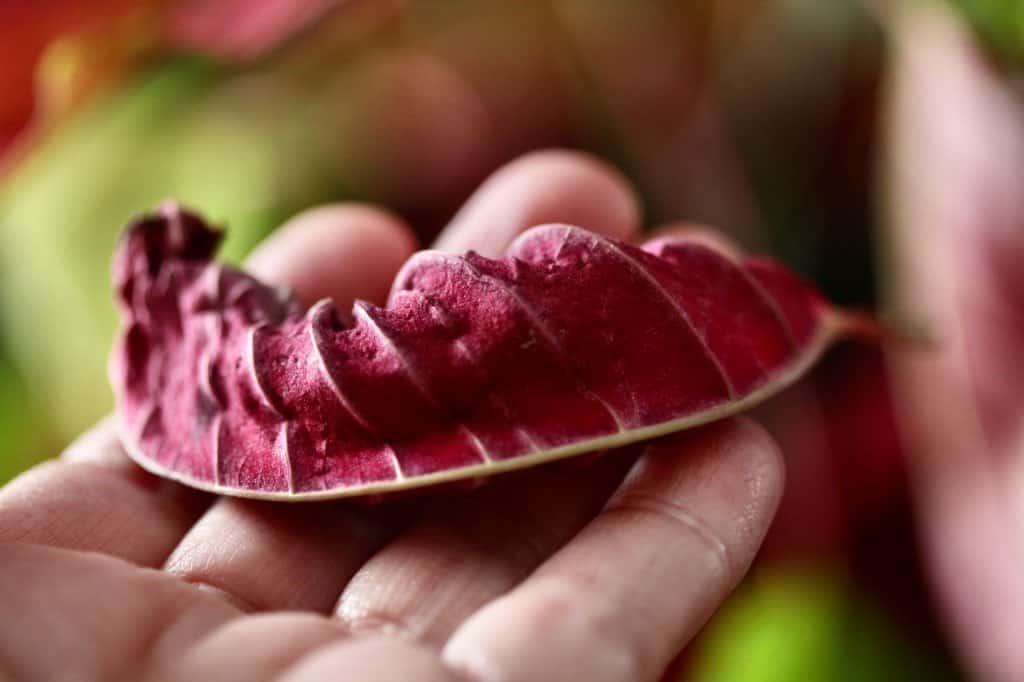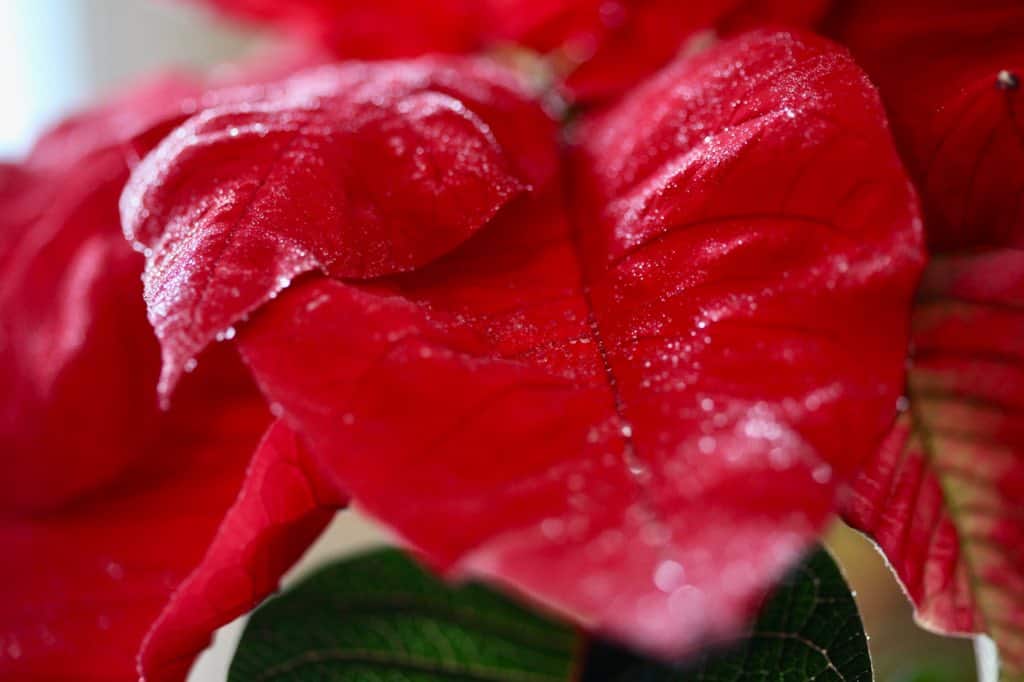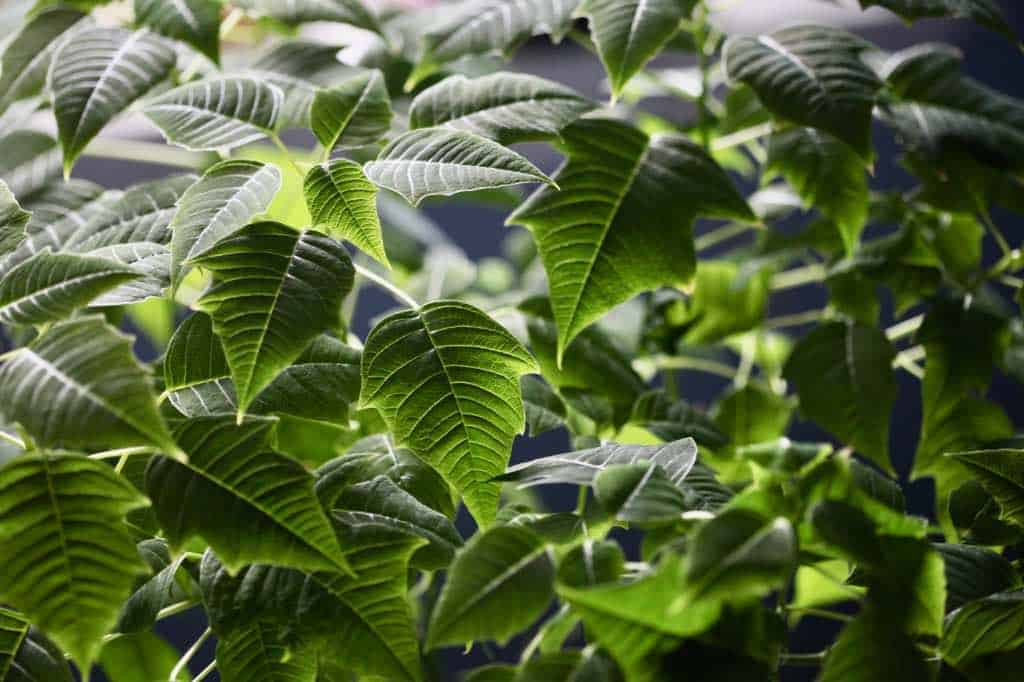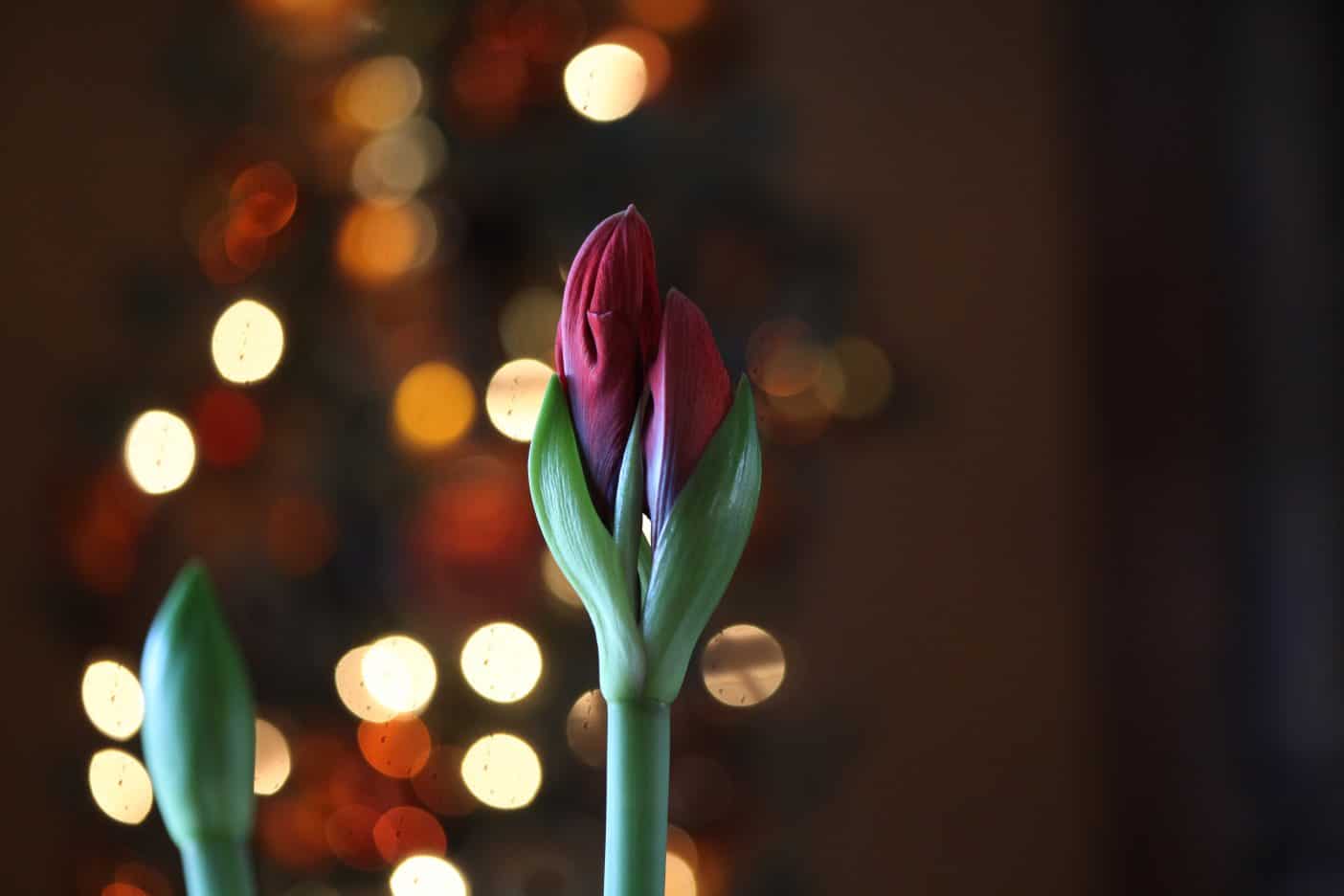Have you ever had a new poinsettia plant that suddenly started to drop it's leaves? These beautiful plants can be a bit sensitive, and respond to the many variances in our home environment. Learn how to save a poinsettia plant, and get your struggling poinsettia back into tip top shape.

Poinsettias are gorgeous plants that are often a part of our holiday traditions.
When we first bring our poinsettia plants home, they are generally in full bloom, and have an appearance that is lush and full. These festive plants compliment the many decorations in our holiday decor during the Christmas season.
However, sometimes they don't tolerate the big change from one environment to the next. Suddenly, the plant may begin to lose leaves, and start to thin out.
You may be doing everything right, taking good care of your poinsettia plant, and the Christmas poinsettia still continues to fade and drop leaves.

Poinsettias Are Sensitive
Sometimes they are given too much love, with extra watering, or a bit too much heat. In our naive attempt to help our wilting plants, we may think they need extra water and so we try to revive them, making things worse.
I have to admit, I have accidentally killed a poinsettia or two by accidentally overwatering.
Now I know what to do, to help to keep poinsettias healthy and blooming.
This thing I know for sure- too much water can cause the demise of an otherwise healthy poinsettia.
So follow along, and I will share some strategies which can be very helpful to save a struggling poinsettia plant. You don't even need to have a green thumb.
All it really takes is a little patience and a little bit of time, and perhaps a little less love (in the form of watering), to have a healthy plant.

About Poinsettia Plants
Poinsettia plants are beautiful tropical plants, often grown inside for the holiday season. They are one of the most popular potted holiday plants during the holiday season.
These plants are actually shrubs or small trees, and if left to grow, have the potential to reach up to 10 feet in height.
Poinsettias have been widely commercialized since introduction to the US market in the 1820's by Joel Roberts Poinsett.
Mr Poinsett was a botanist and a United States Minister to Mexico. The common name for the plant, Poinsettia, is named after him.
Poinsettia is a member of the Family Euphorbiaceae, and Genus Euphorbia. The species name of the plant is Euphorbia pulcherrima.
Poinsettia plants are native to Mexico and Central America, and are tropical in nature. Wild poinsettias grow in their native habitats along Pacific slopes, and in tropical dry forests, known for long periods of seasonal drought.
Poinsettias have been cultivated over the years to produce bushy and hardy plants for growing indoors. They do however maintain their tropical tendencies, and are not cold tolerant.

Poinsettia Flowers
The poinsettia flower grows at the tip of a poinsettia stem, in the center of the bracts.
These yellow flowers consists of a single female flower without petals or sepals, surrounded by male flowers, all of which are enclosed in a cup like structure called a cyathium.
It is common for poinsettia to drop bracts as well as some leaves, once the poinsettia flower has finished blooming. This occurs when the flower has shed it's pollen.
This leaf dropping phenomenon is also enhanced if the plant is exposed to stressors in the environment.



Poinsettia Bracts
The bracts on poinsettias are the colourful modified leaves.
Some people think that these red leaves are the flowers, however the flowers appear above the bracts at the tips of the stems, and are often very small and unassuming on many varieties.
The colorful bracts add a bright accent to our holiday decor.
The plants are available in many colorful varieties, including the traditional red holiday poinsettia, as well as different shades of pink, salmon, white and cream. You can also find variegated colors as well.
Bract Shedding Can Be Normal Or A Sign Of Stress
When the poinsettia plant has finished blooming, it will often shed the bracts from the stems. This can also occur when the plant becomes stressed.

Some may wonder if their poinsettia has died when there is leaf and bract loss. Many poinsettia owners even toss the plant at the end of the season.
It is however possible to save your poinsettia plant.
Instead of discarding the poinsettia plant, there are things that you can do to promote new leaf growth.
In a short time the plant will fill in again, and can be grown as a houseplant, with the right care.
It is also possible for repeat blooming during the next holiday season, with restriction of light in the months prior to flowering, and providing a certain amount daylight hours as well.

Sunlight And Poinsettias
Poinsettias are considered to be short-day plants. As the hours of sunlight are reduced in the shorter days of fall and winter, the plants are exposed to longer periods of darkness.
Longer nights will stimulate growth of the colourful bracts, as the plant begins to bloom for another season.
You can enhance the development of the colourful bracts, by restricting the light to your poinsettia at this time.
The poinsettia plant should receive at least 14 hours of complete darkness every day. The plant will also need at least 6 hours of indirect sunlight per day.
You can restrict sunlight to your poinsettias by putting the plants in a dark room, pulling the window blinds, putting the plants in a dark cupboard, or even covering them with a cardboard box (if they are small enough to fit).
Make sure to remember to uncover them the next morning, or pull up the blind every day, to provide the necessary sunlight as well.
Providing the right amounts of sunlight and darkness will allow for a reblooming poinsettia next Christmas.

How To Save A Poinsettia Plant
Poinsettias are sensitive to temperature, light and water in our home environment. They will adapt however to a regular location, wherever they are placed, as long as it does not provide ongoing stress.
If your poinsettia has started to drop it's leaves, which are withering and drying, all is not lost.
Many a poinsettia has been tossed at this stage, not knowing that the plant can bounce back with a little bit of care.
With a little extra tlc, and some poinsettia care tips, you will be able to grow your poinsettia on.

Check For Root Rot
Poinsettias are prone to develop Pythium root rot with excessive moisture and over watering.
If your plant shows signs of leaf loss and stress, check the root ball for evidence of this disease.
Evidence of root rot includes loss of lower leaves and curling of the leaves, as well as a brown and mushy root system.
If root rot has occurred, the plant will usually not survive.
If there is no evidence of root rot, continue to care for your poinsettia, even though it may continue to lose more leaves.

Gather Spent Leaves As They Fall
Gather the dead leaves as they fall, and make sure to remove any that have fallen into the pot.
This will help to keep the plant tidy, as well as prevent molding in the container where the poinsettia is growing.


Allow The Plant To Dry Out Between Waterings
This aspect of poinsettia care is very important.
These same plants that we bring into our homes during the holidays have genetic origins from tropical dry forests. Poinsettias benefit from drying out slightly between watering.
If you feel tempted to water your poinsettia, feel the surface of the soil. Check to see if the surface is still damp or moist, and if it is, resist the urge to water.
If the plant is showing signs of stress, although the soil is still moist, the stressed appearance may be due to other factors.
Learn more about how to water your poinsettia plant, including frequency and amount, here.
Allow your plant to guide you, and you will get a feel for how often you will need to water.

Water Thoroughly When Dry
Hold off on watering until the soil surface of the potted poinsettia is dry to the touch.
Try not to leave the plant in this dry state for too long however, as this will also cause plant stress.
I water my poinsettia plants approximately once per week.
As soon as the soil surface begins to feel dry, the plants are watered.
To water the plants, take them to the sink if at all possible ( if they are small enough and mobile ). With warm tepid water, drench the plant, watering from the surface of the soil, allowing the water to drain from the bottom of the pot into the sink.
Water very well, and totally drench the soil within the pot.
Misting poinsettia plants with a fine mist from a spray bottle from time to time is also helpful, especially if the air is warm and dry.


Do Not Allow To Sit In Standing Water
Drainage holes in the pot are essential to help prevent the soil, and vulnerable poinsettia roots, from sitting in water.
Let the pot sit in the sink for a few minutes, allowing for the excess water to drain.
Once the pot has finished draining, it can be returned to it's usual location.
Establish A Regular Watering Schedule
Your poinsettia plants will respond to a regular watering schedule, according to their needs.
Watering regularly will promote a healthier less stressed plant.
The plants will adapt to the watering schedule over time, and become fairly hardy, and less likely to show signs of stress.

Place In A Warm And Sunny Location
Poinsettias are tropical plants, and flourish in a warm and sunny environment. They require plenty of natural light to maintain their good condition.
Indirect light is best, with morning sun and indirect afternoon light. Place in a well-lit room with lots of indirect light.
Placement of your poinsettia plant in a sunny window will also provide good light, as long as it is not hot and direct sun, such as what the plant would receive on the south side of the house in warmer seasons.
If at all possible place in an east facing window, which will receive morning sunlight. Make sure that the placement is not in a cold window with cold drafts.

Avoid Drafts And Temperature Fluctuations
Keep away from doorways where the plants may be exposed to cold winter blasts of air, such as doorways to the outside, and winter freezing.
At the same time, try to avoid placement near heaters or excessive heat sources, which can also have a detrimental effect on the plants.
Keep the temperature relatively consistent in the location where you have placed your poinsettias.
Daytime temperatures should be a comfortable room temperature. Nighttime temperatures can be a little lower, as long as the plants are not exposed to wide variances of temperature.

Be Consistent In Your Care
Poinsettia plants respond well to consistent care.
If your plant has dropped leaves from dormancy or stress, you may be able to save your poinsettia plant with a bit of patience and consistent care.
As you care for your plant you may begin to see new shoots forming on the stems.
Adapting to their new location in your home, the poinsettias will leaf out and grow. Poinsettias can actually make beautiful house plants.
The plants will be mostly green, until the seasons change and the hours of sunlight decrease.
With the right balance of darkness and sunlight in the months preceding the Christmas holidays, the plants are then able to produce some colourful bracts once more. Next year your poinsettia may bloom again.
The right balance of darkness to light includes at least 14 hours of darkness every day, along with daily periods of sunlight ( at least 6 hours ), for 6 to 8 weeks prior to blooming.


Repot And Prune As Needed
As your poinsettia plant grows, it will eventually need to be repotted into a new pot or a slightly larger container.
Bump up the container size, and replant into new potting soil.
Water in thoroughly after replanting.
The plant can also be pruned at this time as well, to reduce it's size, if needed. This step is purely optional, however will result in a fuller plant.
Prune back by the stems of the plant with sharp clean pruners, by one third of the plant's size.
Mist the cut stems with a spray bottle after pruning, to reduce the seepage of milky sap from the cut stems.

Fertilizing Your Poinsettia
If you keep your poinsettia to grow on, long past the holiday season, it will benefit from fertilizing.
Application of a regular all purpose houseplant fertilizer once a month after the plant has finished blooming, will help with growth.
There is no need to fertilize your poinsettia while it is actively blooming.

Frequently Asked Questions
Are Poinsettias Hard To Keep Alive?
Poinsettias are not hard to keep alive.
Even if the plants start to drop their leaves along with their colourful bracts, they can bounce back quickly with the proper care.
Depending on where you purchased your poinsettia, it may already have a history of inconsistent temperatures and watering.
If you took it home on a cold winter day, it will likely be exposed to further stress as it adapts to the changes in it's environment.
Losing leaves is a sign of stress, as well as post bloom leaf and bract loss, and is common.
If you keep caring for your plant, it is likely to survive and regrow.
It is fairly easy to save a poinsettia plant.

How Long Do Indoor Poinsettias Live?
Indoor poinsettias can live for years as a houseplant, if they are cared for with consistency.
They will adapt to the environment where they are growing, as long as they are given the right poinsettia care.
Do You Water Poinsettias Every Day?
Watering poinsettias every day may result in their demise.
It is important to water poinsettias only when the top of the soil surface is dry to the touch.
The duration between waterings is dependent on the plant, including size and moisture uptake, as well as the environment, including heat and humidity.
Water thoroughly when dry, and allow the moisture to completely drain from the pot, so that the plant is not left sitting in standing water.

Why Are My Poinsettia Leaves Falling Off?
Leaves of poinsettias, as well as the colourful bracts, may fall off after flowering.
The leaves and bracts also have a tendency to fall whenever the plant has become stressed.
This will occur if exposed to extremes of temperature, as well as extremes of watering (either too little or too much).
Will A Poinsettia Come Back After Loosing It's Leaves?
A poinsettia will come back after losing it's leaves, as long as it has not developed root rot.
Continue to care for the plant by providing the right environment and care, and it will reward you with new growth in no time at all.

Conclusion
Poinsettia plants help to make our festive season just a little bit brighter, and certainly add to our Christmas decor.
Bringing home a poinsettia is often a part of the holiday tradition for many families.
With the many poinsettia varieties available, your may have many color choices to chose from.
If you have what you suspect is a dying poinsettia, losing it's leaves from leaf drop, look a little closer at the plant before you toss it. More than likely you will be able to save your poinsettia plant.
The good news is that by providing the right poinsettia care, your Christmas plant will be able to live on, long past the holiday season, and even into the next season, and the following Christmas.

Have you ever tried to save a poinsettia plant? Be sure to leave a comment below to share your experience!
Other Posts You May Like:
PIN IT FOR LATER!










Leave a Reply